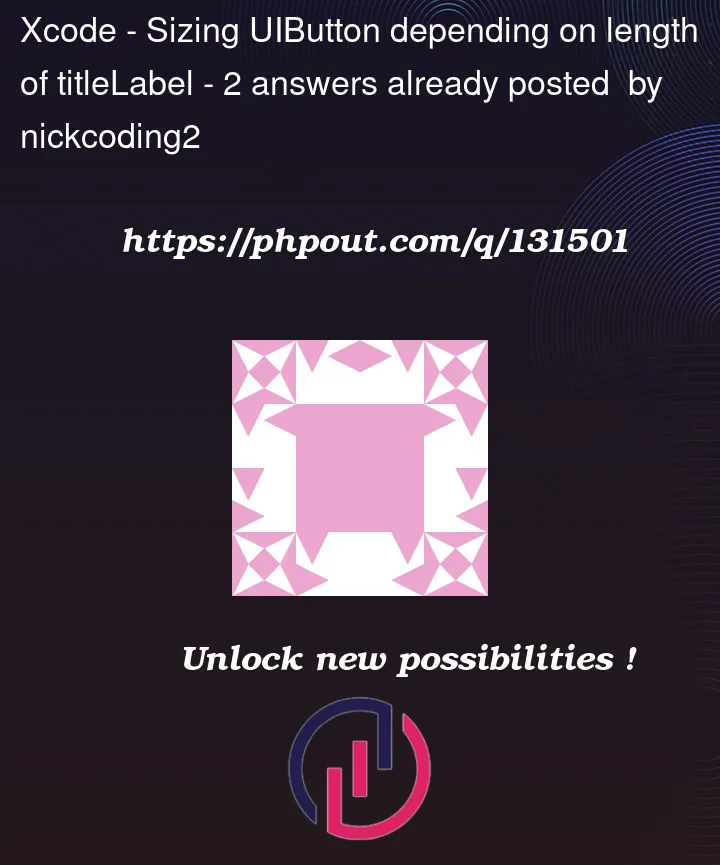So I have a UIButton and I’m setting the title in it to a string that is dynamic in length. I want the width of the titleLabel to be half of the screen width. I’ve tried using .sizeToFit() but this causes the button to use the CGSize before the constraint was applied to the titleLabel. I tried using .sizeThatFits(button.titleLabel?.intrinsicContentSize) but this also didn’t work. I think the important functions below are the init() & presentCallout(), but I’m showing the entire class just for a more complete understanding. The class I’m playing with looks like:
class CustomCalloutView: UIView, MGLCalloutView {
var representedObject: MGLAnnotation
// Allow the callout to remain open during panning.
let dismissesAutomatically: Bool = false
let isAnchoredToAnnotation: Bool = true
// https://github.com/mapbox/mapbox-gl-native/issues/9228
override var center: CGPoint {
set {
var newCenter = newValue
newCenter.y -= bounds.midY
super.center = newCenter
}
get {
return super.center
}
}
lazy var leftAccessoryView = UIView() /* unused */
lazy var rightAccessoryView = UIView() /* unused */
weak var delegate: MGLCalloutViewDelegate?
let tipHeight: CGFloat = 10.0
let tipWidth: CGFloat = 20.0
let mainBody: UIButton
required init(representedObject: MGLAnnotation) {
self.representedObject = representedObject
self.mainBody = UIButton(type: .system)
super.init(frame: .zero)
backgroundColor = .clear
mainBody.backgroundColor = .white
mainBody.tintColor = .black
mainBody.contentEdgeInsets = UIEdgeInsets(top: 10.0, left: 10.0, bottom: 10.0, right: 10.0)
mainBody.layer.cornerRadius = 4.0
addSubview(mainBody)
// I thought this would work, but it doesn't.
// mainBody.translatesAutoresizingMaskIntoConstraints = false
// mainBody.topAnchor.constraint(equalTo: self.topAnchor).isActive = true
// mainBody.leftAnchor.constraint(equalTo: self.rightAnchor).isActive = true
// mainBody.rightAnchor.constraint(equalTo: self.rightAnchor).isActive = true
// mainBody.bottomAnchor.constraint(equalTo: self.bottomAnchor).isActive = true
}
required init?(coder decoder: NSCoder) {
fatalError("init(coder:) has not been implemented")
}
// MARK: - MGLCalloutView API
func presentCallout(from rect: CGRect, in view: UIView, constrainedTo constrainedRect: CGRect, animated: Bool) {
delegate?.calloutViewWillAppear?(self)
view.addSubview(self)
// Prepare title label.
mainBody.setTitle(representedObject.title!, for: .normal)
mainBody.titleLabel?.lineBreakMode = .byWordWrapping
mainBody.titleLabel?.numberOfLines = 0
mainBody.sizeToFit()
if isCalloutTappable() {
// Handle taps and eventually try to send them to the delegate (usually the map view).
mainBody.addTarget(self, action: #selector(CustomCalloutView.calloutTapped), for: .touchUpInside)
} else {
// Disable tapping and highlighting.
mainBody.isUserInteractionEnabled = false
}
// Prepare our frame, adding extra space at the bottom for the tip.
let frameWidth = mainBody.bounds.size.width
let frameHeight = mainBody.bounds.size.height + tipHeight
let frameOriginX = rect.origin.x + (rect.size.width/2.0) - (frameWidth/2.0)
let frameOriginY = rect.origin.y - frameHeight
frame = CGRect(x: frameOriginX, y: frameOriginY, width: frameWidth, height: frameHeight)
if animated {
alpha = 0
UIView.animate(withDuration: 0.2) { [weak self] in
guard let strongSelf = self else {
return
}
strongSelf.alpha = 1
strongSelf.delegate?.calloutViewDidAppear?(strongSelf)
}
} else {
delegate?.calloutViewDidAppear?(self)
}
}
func dismissCallout(animated: Bool) {
if (superview != nil) {
if animated {
UIView.animate(withDuration: 0.2, animations: { [weak self] in
self?.alpha = 0
}, completion: { [weak self] _ in
self?.removeFromSuperview()
})
} else {
removeFromSuperview()
}
}
}
// MARK: - Callout interaction handlers
func isCalloutTappable() -> Bool {
if let delegate = delegate {
if delegate.responds(to: #selector(MGLCalloutViewDelegate.calloutViewShouldHighlight)) {
return delegate.calloutViewShouldHighlight!(self)
}
}
return false
}
@objc func calloutTapped() {
if isCalloutTappable() && delegate!.responds(to: #selector(MGLCalloutViewDelegate.calloutViewTapped)) {
delegate!.calloutViewTapped!(self)
}
}
// MARK: - Custom view styling
override func draw(_ rect: CGRect) {
// Draw the pointed tip at the bottom.
let fillColor: UIColor = .white
let tipLeft = rect.origin.x + (rect.size.width / 2.0) - (tipWidth / 2.0)
let tipBottom = CGPoint(x: rect.origin.x + (rect.size.width / 2.0), y: rect.origin.y + rect.size.height)
let heightWithoutTip = rect.size.height - tipHeight - 1
let currentContext = UIGraphicsGetCurrentContext()!
let tipPath = CGMutablePath()
tipPath.move(to: CGPoint(x: tipLeft, y: heightWithoutTip))
tipPath.addLine(to: CGPoint(x: tipBottom.x, y: tipBottom.y))
tipPath.addLine(to: CGPoint(x: tipLeft + tipWidth, y: heightWithoutTip))
tipPath.closeSubpath()
fillColor.setFill()
currentContext.addPath(tipPath)
currentContext.fillPath()
}
}
This is what it looks like for a short title and a long title. When the title gets too long, I want the text to wrap and the bubble to get a taller height. As you can see in the image set below, the first ‘Short Name’ works fine as a map annotation bubble. When the name gets super long though, it just widens the bubble to the point it goes off the screen.
Any help on how to fix is much appreciated. Thanks!




2
Answers
The
UIButtonclass owns thetitleLabeland is going to position and set the constraints on that label itself. More likely than not you are going to have to create a subclass ofUIButtonand override its "updateConstraints" method to position thetitleLabelwhere you want it to go.Your code should probably not be basing the size of the button off the size of the screen. It might set the size of off some other view in your hierarchy that happens to be the size of the screen but grabbing the screen bounds in the middle of setting a view’s size is unusual.
To enable word-wrapping to multiple lines in a
UIButton, you need to create your own button subclass.For example:
That button will wrap the title onto multiple lines, cooperating with auto-layout / constraints.
I don’t have any projects with MapBox, but here is an example using a modified version of your
CustomCalloutView. I commented out any MapBox specific code. You may be able to un-comment those lines and use this as-is:Here is a sample view controller showing that "Callout View" with various length titles, restricted to 70% of the width of the view:
It looks like this: